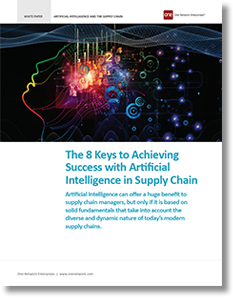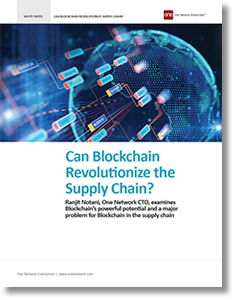3 Ways to Get Value from Artificial Intelligence

Computers are smart, but no match for a human assisted by a computer using a smart process, and AI is not myopically about removing people, but a way to extend our reach, improve our lives and help us make smarter decisions faster.
There’s a lot of buzz about machine learning and artificial intelligence (AI), and for good reason.
AI is starting to make its presence felt. Alexa and Siri are in our homes, Watson is at work, and self-driving cars may soon shuttle us between the two.
Now many executives are wondering how best to incorporate AI into their business strategy.
The answer is not necessarily to replace people with robots.
I believe that a more pragmatic approach is to consider three guiding principles.
1. Take the Robot Out of the Human
The first and lowest hanging fruit for AI applications has always been to automate the most routine and mechanical tasks that humans do so as to free them up to focus on higher value tasks.
Berruti, Nixon, Taglioni, and Whiteman call this “taking the robot out of the human”. [1]
The idea is to automate some of the tasks by carefully delegating tasks between man and machine to get the most effective outcome.
I learned this concept as a first principle in an AI class at Berkeley over 30 years ago and I believe it remains just as applicable today.
In those days, AI practitioners would do what we called “knowledge engineering” to solicit and document the decision approach and mental models of experts.
There is a lot more value in keeping your experts and having them focus on the toughest, most subjective problems than trying to replace them.
One of my clients, Alan Pendleton of Republic Wireless recently said it best:
“We want our supply chain team to spend more time thinking and a lot less time doing. We want them to be strategic thinkers, decision makers, negotiators, and ultimately advocates for the customer experience – not order expediters.”
2. Help More People Perform Like Experts
The second and natural by-product of building decision models is that we are able to identify insights that can help more people to replicate the insights and trade-offs experts or smart algorithms have uncovered.
I call this “institutionalizing knowledge”. It is like having an expert looking over your shoulder and guiding you.
The expert may not be as close to the specific problem you are looking at and may not have all the meanings in between the lines but can offer you guidance based on what worked well and what to watch out for from years of experience (or in this case - lots of training data).
3. Making Better Decisions
The third way AI creates value is helping everyone - experts included - make better decisions. This is where the power tool paradigm comes in.
Computers can sift through big data and derive insights and they can crunch a lot of numbers to find optimized decisions. In 1997 IBM’s Deep Blue defeated world chess champion Garry Kasparov.
Since then, in “freestyle” chess championships teams of any combination of computers and humans compete routinely. In 2005, Kasparov has himself observed that the winner was not a grandmaster with a state of the art PC but a pair of amateur chess players who used a smart process to guide three computers at the same time to look deeply into positions.
These amateurs beat grandmasters opponents with greater computational power through a smarter process of leveraging man and machine together. [2]
Computers are smart, but no match for a human assisted by a computer using a smart process.
So in the end, AI is not myopically about removing people. I see it as a way to extend our reach, improve our lives and help us make smarter decisions faster.
References
[1] “Intelligent process automation: The engine at the core of the next-generation operating model” McKinsey, March 2017.
[2] The Second Machine Age, Erik Brynjolfsson and Andrew McAfee, W. W. Norton Company, 2014
Related Article: 8 Fundamentals for Achieving Artificial Intelligence Success in the Supply Chain
Related White Papers
8 Keys to Achieving Success with Artificial Intelligence in Supply Chain
This white paper looks at the fundamentals that supply chains need in place in order to achieve real results from Artificial Intelligence implementations. Download Now!
Can Blockchain Revolutionize the Supply Chain?
In this white paper Ranjit Notani, One Network CTO examines Blockchain’s powerful potential as well as a major problem and whether and how Blockchains can revolutionize the Supply Chain. Download Now!
The Internet of Things and Your Supply Chain
This white paper offers a quick and clear guide to the Internet of Things (IoT), it explains why this technology is so exciting for supply chain and offers a few examples of how it and related technology can be used to dramatically cut costs. Download Now!
Article Topics
One Network Enterprises News & Resources
Blue Yonder announces an agreement to acquire One Network Enterprises for $839 million Blue Yonder Acquires One Network Enterprises for $839M Companies Need to Develop New Innovative Approaches to Supply Chain Design How to Improve Cost of Goods Sold Horizontally Across the Supply Chain How the Global Pandemic Accelerated Supply Chain Visibility, Digitalization, and Automation AI and Data, the Future of Supply Chain Management AI and Supply Chain Problem Solving More One Network EnterprisesLatest in Technology
Spotlight Startup: Cart.com is Reimagining Logistics Walmart and Swisslog Expand Partnership with New Texas Facility Taking Stock of Today’s Robotics Market and What the Future Holds Biden Gives Samsung $6.4 Billion For Texas Semiconductor Plants Apple Overtaken as World’s Largest Phone Seller Walmart Unleashes Autonomous Lift Trucks at Four High-Tech DCs Talking Supply Chain: Procurement and the AI revolution More Technology

















